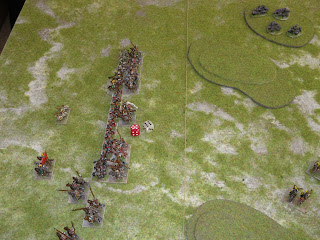The following battles were a rigorous test of Rome’s capabilities
as they were fought on Sarmatian home terrain, the steppe. Although the
advantages were clearly in Sarmatian favour, Rome did produce a few surprises. No
doubt the balance in the games might have shifted with the use of the Alani as
an allied contingent or the employment of Sarmatian psiloi, the sight of eleven
knight elements is truly one to behold.
II/64b Middle
Imperial Roman (Western)
1 x general (Cv), 1 x cavalry (Cv), 1 x horse archer
(LH), 4 x legionnaires (4Bd), 3 x auxiliary (4Ax), 1 x archers (4Bw), 1 x Cataphract (3Kn).
II/26
Sarmatian
1 x general (3Kn), 10 x armoured cavalry (3Kn), 1 x
horse archer (LH).
Game one
Facing a long line of Sarmatian knights Rome deployed
in three lines with the right flank comprised all the mounted reserve. The
first two lines would wheel to the right forming a new contiguous line forcing
the Sarmatian to conform or attack piecemeal.
30 minutes later both lines conformed and the light
horse of both sides opened the battle.
The Sarmatian line struck first to sweep clean through
the Roman line of infantry, the battle was over for the loss of one unit. Score
6 – 1 for Sarmatia.
Game two
Rome deployed in two lines and taking advantage of two
low hills strengthened the flanks of the infantry with extra auxilia and
legionnaires; covering the Roman reserve were a unit of archers and another of
auxilia. The Sarmatian army formed one long line of knights with their general,
noticeable by his white Draco standard, positioned in centre.
Both sides advanced cautiously forward with the Romans
remaining for the most part on the slopes of the hill.
Surprising the Sarmatians, Rome launched both wings
forward which pushed back the Sarmatian left and opened the right flank to
imminent danger.
Rome withdrew most of the cavalry to form up to the
right of the infantry line. By now the Roman left and centre were engaging the
enemy cavalry. Losses on both sides quickly rose as the slopes of the hill were
littered with dead horses and riders. Isolated Roman units were picked off by
Sarmatian bow and kontos bringing the score even, 3 – 3.
Roman troops were in a frenzy surrounding the
Sarmatian general and his guard and other single units of knights.
Unfortunately, Fortuna decided to set her gaze elsewhere and the Sarmatian
general survived the onslaught dispatching his direct opponent. Despite the
increase loss, the battle ended 5 – 4
for Sarmatia.
Game
three
This time Rome had been caught in the open and had
time to deploy two formations while the remainder of the army formed further
back.
Rome gathering second wind could form a new line with
cavalry supporting the immediate flanks of the legionnaires with auxilia
extending the battle line further outward and the Illyrian cavalry were seen
encircling the entire Sarmatian force.
The entire Sarmatian line surged forward fully
confident of a quick victory, but this time Fortuna smiled as the entire Roman
line held sending the Sarmatian cavalry back
and destroying two units flanking their commander.
Rome did not hesitate and charged forward catching and
number of cavalry units struggling to evade. Victory was complete as the white Draco
standard fell to earth. Score 2 – 5 for
Rome.
NB. On a side note, the Roman general faced the rear
throughout the battle which can be explained in two ways. He showed either a
great contempt for the enemy and spread manure in their path or he was in deep
conversation with Fortuna.













No comments:
Post a Comment